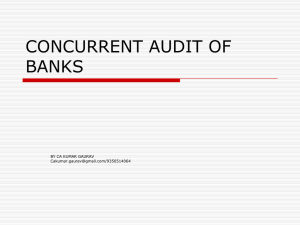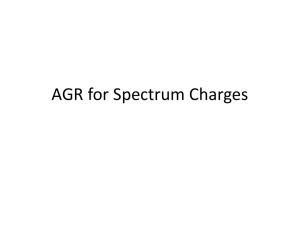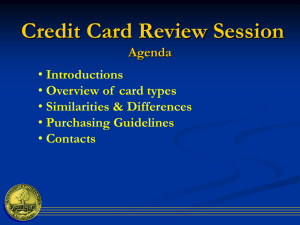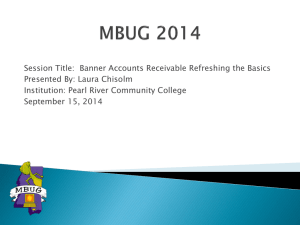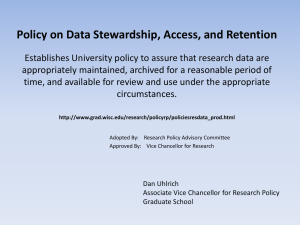Divisions of States HIV AIDS Programs (DSHAP)
advertisement
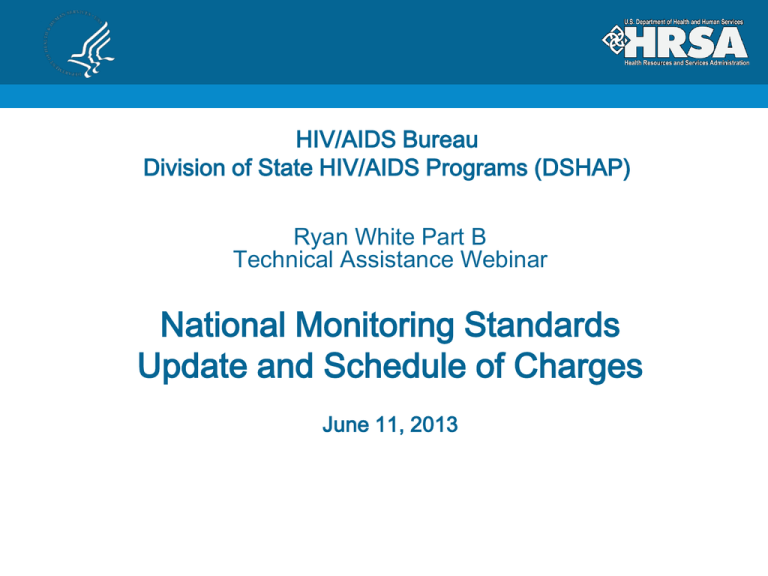
HIV/AIDS Bureau Division of State HIV/AIDS Programs (DSHAP) Ryan White Part B Technical Assistance Webinar National Monitoring Standards Update and Schedule of Charges June 11, 2013 HAB DSHAP Mission To provide leadership and support to States/Territories for developing and ensuring access to quality HIV prevention, health care, and support services. Presenters: Heather Hauck Director, Division of State HIV/AIDS Programs Harold Phillips Deputy Director, Division of State HIV/AIDS Programs Agenda Opening Remarks/ Announcements Heather Hauck Question and Answer Session 1 National Monitoring Standards Update and Schedule of Charges Harold Phillips Questions and Answer Session 2 Closing Remarks Heather Hauck Announcements Heather Hauck, Director Division of State HIV/AIDS Programs HIV/AIDS Bureau Question and Answer Session Division of State HIV AIDS Programs Webinar Series National Monitoring Standards and Schedule of Charges June 11, 2013 Harold J. Phillips, MRP Deputy Director Department of Health and Human Services (HHS) Health Resources and Services Administration (HRSA) HIV/AIDS Bureau (HAB) Divisions of States HIV AIDS Programs (DSHAP) Presentation Agenda • The Purpose of the National Monitoring Standards (NMS) • The Process of Implementation • Recent Changes/Updates to Standards • Resource Tools for Implementation What are the NMS? • Compilation of all major Ryan White Program documents used for COMPLIANCE, OVERSIGHT & EXPECTATIONS • Designed as a set of minimum expectations for use by all Part A & Part B (including ADAP) grantees and subgrantees on administration and program and fiscal monitoring • Developed by HRSA/HAB and Expert fiscal and program consultants • Contributions and Involvement: • • • • HAB Legal Council Government Accountability Office HRSA Office of Communications Part A & B grantee workgroups • Dissemination: • • • Draft in July of 2010 Published April 2011 Updated April 2013 Purpose of the NMS • Clarify the oversight expectations of Ryan White Part A & Part B Programs • Design a specific set of minimum expectations for monitoring • Provide a single source for both program and fiscal monitoring • Specify the roles of HRSA and Grantees regarding the monitoring of subgrantees • Address concerns of HRSA, Congress and OIG regarding oversight issues Purpose of the NMS • Designed to aid grantees in meeting minimal expectations for: • Fiscal and Program Management • Monitoring providers/subgrantees • Reporting • Designed to streamline, standardize and improve program efficiency and responsiveness. Purpose of the NMS • Compliance & Oversight & Expectations • Ryan White Legislation • Code of Federal Regulations • HHS Grants Policy Manual • HRSA/HAB Policies • Parts A and B Program Guidance • Part A and Part B Manuals (clarification, best practice) • Program Terms and Conditions of Award • OIG/GAO Reports and Recommendations NMS Implementation Process • National Monitoring Standards Packet for Ryan White Part B contains: Universal Monitoring Standards Fiscal Monitoring Standards** Program Monitoring Standards** Frequently Asked Questions • • • • • Each individual monitoring standard • • • • Connected to a source which is cited Has a grantee and/or sub grantee responsibility Performance measure/method Clearly stated performance measure and method NMS Implementation Process • Grantees are expected to comply with all of the standards • Grantees can develop their own ways to measure compliance • There is flexibility regarding how to implement the monitoring standards • Implementation is a process • May require re-thinking, revising long-used practices with regard to monitoring • May require changes in tools, process, systems, procedures, staffing patterns, fiscal and program management and reporting NMS April 2013 Updates Item Tracking Charges (Provider or Client) Change Clarification Source Legislation Rent as Administrative FAQ #55 Cost Clarification DMHAP/DSHAP Program letter: July 17, 2012 -Administrative Costs Audits FAQ #57 and #58 Clarification, new standard DMHAP/DSHAP Program letter: September 20, 2012 –Audits Site Visit Exemption FAQ #23 Clarification DMHAP/DSHAP Program letter: October 4, 2012 Site Visit Exemption Eligibility Determination Limitation on Charges (previously cap on charges) FAQ #34 New standard Policy Clarification Notice (PCN) 13-02 Through out Terminology Update Legislative language Through out Schedule of Charges (previously Sliding Fee Scale) Terminology Update Legislative language Through out Terminology Update HAB Reorganization Division Names (DMHAP/DSHAP) Location FAQ #60 and #62 Technical Assistance • Work with your project officer • Technical Assistance • Consultant, Peer to Peer, HAB staff • Cooperative Agreements • Target Center Resources (tools, samples, AGM presentations) • Please send copies of monitoring tools to PO’s to share with other grantees • Individualized conference calls • National webinars/conference calls Imposition of Charges and Application of Sliding Fee Scale) Assessment and Schedule of Charges under Ryan White Outline of this session • • • • • • • • • • A few definitions for clarity Legislative Requirements Regarding Fees Basics of RW Charges for Services/Fees Eligibility Process Federal Poverty Level Sliding Fee Scale Requirements Nominal Fees Annual Limitation on Charges How to Implement How to Monitor A Few Important Terms • Costs are the accrued expenditures incurred by the grantee/subgrantee during a given period requiring the provision of funds for: (1) goods and other tangible property received; (2) services performed by employees, contractors, subgrantees, subcontractors, and other payees. • Charges are the imposition of fees upon payers for the delivery of billable services • Payments are the collection of fees from payers that are applied to cover some aspect of costs of billable services Charges for Services • Billable services are those for which there is a payer • Charges are the fees applied to billable services • Payers can include Medicare, Medicaid, insurance companies and clients. • Payments are the collection of fees from payers that are applied to cover some aspect of the costs of billable services • Charge Master/Schedule of Charges is a comprehensive listing of prices for billable services and/or procedures Legislative Requirements Regarding Charges/Fees • RW Schedule of Charges (Sliding Fee Scale) Requirements have a historical connection to Public Health Service Act Section 330 -Health Center Programs such as: • • • • Community health centers Federally Qualified Health Centers and Look-Alikes Migrant Health Centers Health Care for the Homeless Legislative Requirements Regarding Charges/Fees • Section 330 Programs and RW Programs are required to have: Schedule of fees for provision of service Fees consistent with locally prevailing rates Fees designed to cover reasonable costs A schedule of discounts applied to fees A discount system based on patient’s ability to pay No patient denied care due to inability to pay A system to waive or reduce fees to assure care received • Pursue payment from third party sources as applicable • • • • • • • Assessment of Client Charges • Conflicts with Ryan White Sliding Fee Scale (SFS) Requirements • Community Health Center SFS Regulations – a. allow for a minimum charge to persons with incomes below 100% of poverty. b. do not allow for a SFS discount for persons with incomes above 200% of poverty. • In these cases at intake and eligibility its important to clarify which program the client is eligible for and being enrolled in and comply with its requirements. Basics of Ryan White Client Charges/Fees • Eligibility Process • Federal Poverty Level (FPL) used to determine ability to pay fees/charges • FPL is based on family size and Income @ 100% of Poverty • Nominal Fee for clients above 100% FPL • Annual Limitation on Charges (Cap on Charges) •Note: Designated free-clinics are exempt and can receive a waiver Basics of RW Client Charges/Fees – Eligibility Procedures • The eligibility process is central to determination of how to apply the sliding fee scale (determination of the discount on charges) • Eligibility Policies and Procedures that: • Meet Ryan White Part B requirements (HIV status, residency, income, and recertification every six months) • Define household and/or individual • Detail whether net or gross income will be used as part of the income determination • If using Modified Adjusted Gross Income (MAGI) Grantees can decide what expenses to deduct • Specify documentation required for proof of income/family Size • Specify process for application of discount pending documentation, retroactively or at the time of service. Basics of RW Client Charges/Fees Imposition of Charges U.S. Poverty Guidelines • Published Annually in the Federal Register • Health and Human Services Posts them on the Web http://aspe.hhs.gov/poverty/index.shtml#latest Federal Poverty Guidelines-2013 Annual Limitation on Charges 100% - 200% 200% - 300% >300% of At or below of Poverty – of Poverty – Poverty – 100% of FPL – No more than No more than No more than 5% of gross 7% of gross 10% of gross annual income annual income annual income 0% Annual Limitation on Charges • Some examples of client charges for care services that may count towards the annual cap on client charges include: • • • • • • • Enrollment Fees Deductibles Co-payments Payments to other providers for care Health Insurance Premiums Co-insurance Other cost sharing Basics of Imposition and Assessment of Charges • How to Implement Process for Imposing Charges • Develop a sliding fee scale policy that correlates with your eligibility process, includes discount policy, nominal charges and caps on charges • Develop discount mechanisms within the billing system • Develop patient education materials and notices to be posted in client areas • Implement staff training and acknowledge it may be a cultural shift from either free or no discounted service models Basics of Imposition and Assessment of Charges How to monitor what Sub-grantees must have in place: • Eligibility process and policy that define household and income • Proof of Income and Family Size in client files • Documented evidence of the use of FPL in determining ability to pay • Charge Master for billable services • Discounted fee schedule • Publicly posted signs indicating nominal fees including that clients cannot be refused service due to inability to pay • Be Medicaid certified if providing Medicaid billable services • Contracts with third party providers • System for charging payers including Medicaid if providing Medicaid billable services • Documented policy of not refusing service due to inability to pay • Process for collecting from payers especially third party payers • Proof of the use of program income to support HIV program Question and Answer Session Contact Information Heather Hauck, Director DSHAP HHauck@hrsa.gov Harold Phillips, Deputy Director DSHAP E-mail: hphillips@hrsa.gov Thank You

